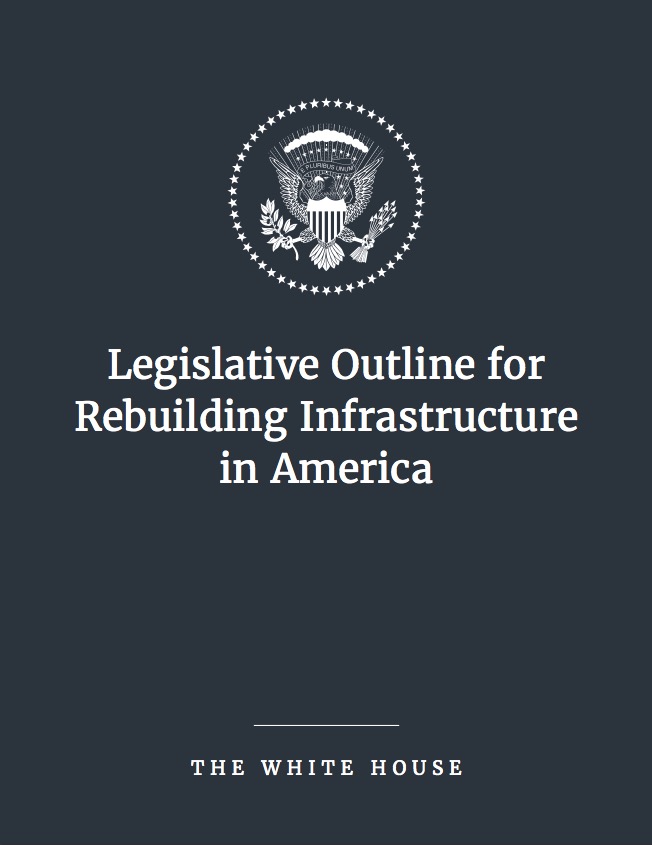THE WHITE HOUSE
PART 1—FUNDING AND FINANCING INFRASTRUCTURE IMPROVEMENTS
I. INFRASTRUCTURE INCENTIVES PROGRAM
 States and localities are best equipped to understand the infrastructure investments needs of their communities. The infrastructure incentives program, described below, would encourage increased State, local, and private investment in infrastructure. This program would provide for targeted Federal investments, encourage innovation, streamline project delivery, and help transform the way infrastructure is designed, built, and maintained.
States and localities are best equipped to understand the infrastructure investments needs of their communities. The infrastructure incentives program, described below, would encourage increased State, local, and private investment in infrastructure. This program would provide for targeted Federal investments, encourage innovation, streamline project delivery, and help transform the way infrastructure is designed, built, and maintained.
Under this program, States and localities would receive incentives in the form of grants. Project sponsors selected for award would execute an agreement with express progress milestones. Federal incentive funds would be conditioned upon achieving the milestones within identified time frames.
A. Establishment of the Incentives Program
This provision would establish the Incentives Program to maximize investment in infrastructure. The purposes of this program would include—
- attracting significant new, non-Federal revenue streams dedicated to infrastructure investments;
- creating significant leverage of Federal infrastructure investments;
- assuring long-term performance of capital infrastructure investments;
- modernizing infrastructure project delivery practices;
- increasing economic growth;
- spurring the development and use of new and rapidly evolving infrastructure technology to improve cost and improve performance; and
- ensuring Federal grant recipients are accountable for achieving specific, measurable milestones.
B. Applicability
The Incentives Program would provide support to wide-ranging classes of assets, including the following governmental infrastructure: surface transportation and airports, passenger rail, ports and waterways, flood control, water supply, hydropower, water resources, drinking water facilities, wastewater facilities, stormwater facilities, and Brownfield and Superfund sites.
C. Funding
- $100 billion would be made available for the Incentives Program. The funds would be divided in specific amounts to be administered by the United States Department of Transportation (DOT), United States Army Corps of Engineers (USACE), and Environmental Protection Agency (EPA).
- Other Federal agencies seeking to incentivize eligible projects within their areas of jurisdiction could petition DOT, USACE, or EPA to transfer Incentives Program funds to be used consistent with the requirements under the program.
- A percentage of the Incentives Program funds would be set aside for temporary administrative expenses necessary to administer the program.
D. Applications and Evaluation Criteria
- Each lead Federal agency would solicit applications as soon as practicable after enactment of the Incentives Program and every six months thereafter.
- Each lead Federal agency would determine the content, format, and timing of applications and would make incentive awards. Applications also would include information on each of the evaluation criteria.
- The evaluation criteria would be—
- the dollar value of the project or program of projects (weighted at 10 percent);
- evidence supporting how the applicant will secure and commit new, non-Federal revenue to create sustainable, long-term funding for infrastructure investments (weighted at 50 percent);
- evidence supporting how the applicant will secure and commit new, nonFederal revenue for operations, maintenance and rehabilitation (weighted at 20 percent);
- updates to procurement policies and project delivery approaches to improve efficiency in project delivery and operations (weighted at 10 percent);
- plans to incorporate new and evolving technologies (weighted at 5 percent); and
- evidence supporting how the project will spur economic and social returns on investment (weighted at 5 percent).
- Each lead Federal agency would calculate each application score by multiplying the weighted score from the evaluation criteria by the percentage of nonFederal revenues (out of total revenues) that would be used to fund the project or program of projects.
- To ensure that applicants could receive credit for actions that occurred prior to the enactment of the Incentives Program that align with the desired outcomes of the program, the Incentives Program would include a look-back period. The look-back period would be defined as the time preceding the project sponsor’s completed application during which the new revenue generation was implemented. Subsequent applications in later years would add such additional time to the time after enactment of the program. The look-back period would be three years before the date of application to the program, and the determination would be made based on the implementation date (or take effect date) of the new revenue source. In evaluating applications, the project sponsor’s new revenue application score would be multiplied by a relevant multiplier to determine scoring as illustrated below:
- The lead Federal agency would have sole discretion to provide credit for previous revenue generation. The agency could request additional information from a project sponsor to clarify how the revenue source has met expectations and revise forecasts to reflect actual performance. The amount of funds dedicated to the look-back would not exceed 5 percent of the total amount for the Incentives Program.
E. Incentive Grant Awards
- An incentive grant could not exceed 20 percent of new revenue.
- Any individual State could not receive more than 10 percent of the total amount available under the Incentives Program.
- The lead Federal agency and the grant recipient would enter into an infrastructure incentives agreement setting forth progress milestones toward obtaining increased revenue that the recipient would achieve prior to receiving the grant award, which could include advance grant disbursements.
- Any agreement with incomplete milestones after two years would be voided, except upon determination by the lead Federal agency that good cause exists to renew the agreement for an additional period not to exceed one year. Any funds available from a voided agreement could be re-allocated through a new application process.
Download full version (PDF): Legislative Outline for Rebuilding Infrastructure in America
Tags: Legislative Outline for Rebuilding Infrastructure in America, The White House, Trump Administration, Trump Infrastructure Plan






 RSS Feed
RSS Feed